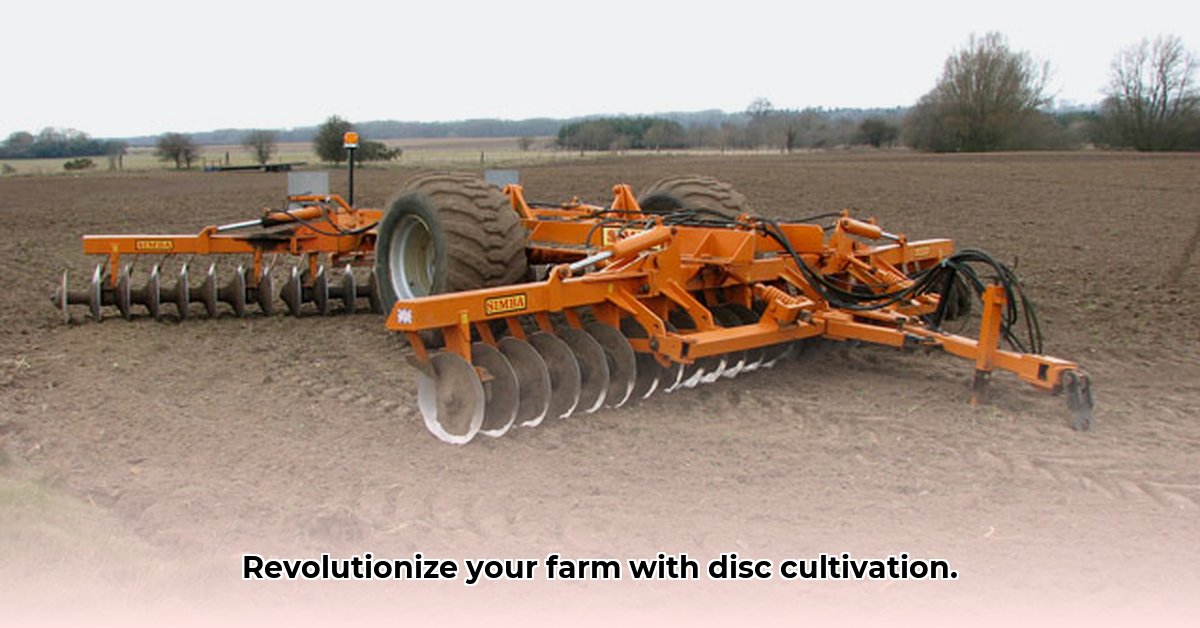
Tractor Disc Cultivator: Your Partner in Sustainable Soil Management
Choosing the right tools is paramount for efficient and environmentally conscious farming. The tractor disc cultivator stands out as a versatile implement capable of significantly improving soil health and boosting yields. This guide explores its capabilities, sustainable applications, and provides a step-by-step guide to maximizing its effectiveness. For more in-depth information, check out this detailed guide on disc cultivator use.
Understanding the Tractor Disc Cultivator: Beyond Basic Tillage
A tractor disc cultivator is a tillage implement designed to break up compacted soil, control weeds, and prepare a seedbed for planting. (It's essentially a more advanced form of plowing). Its effectiveness depends on factors such as soil type, operating depth, and disc angle. Unlike simpler plows, disc cultivators offer greater versatility and control, allowing for adjustments to suit various soil conditions and farming techniques. The number of discs influences the intensity of tillage, while the angle of the discs determines the aggressiveness of soil mixing.
"By carefully selecting a disc cultivator appropriate for your soil conditions and optimizing its usage, you can significantly reduce the need for herbicides and contribute to a more resilient and sustainable farming practice." — Dr. Emily Carter, Soil Science Department, University of California, Davis.
Did you know that efficient soil preparation can lead to a 15% increase in crop yield? This translates directly to higher profits and a smaller environmental footprint.
Sustainable Farming with a Disc Cultivator: Enhancing Soil Health
Sustainable farming practices prioritize environmental stewardship alongside profitability. The responsible use of a disc cultivator is key to achieving this balance. By breaking up compacted soil, you improve drainage, aeration, and root penetration, creating a healthier environment for plant growth. This reduction in soil compaction leads to a decreased reliance on chemical herbicides and pesticides, minimizing environmental impact and contributing to healthier soil ecosystems.
"Less chemical dependence leads to healthier soil, and healthier soil leads to healthier plants. It’s a win-win scenario, contributing to a thriving farm and a healthier planet." — Dr. Anya Sharma, Agricultural Sustainability Consultant, World Wildlife Fund (WWF).
A recent study showed that farms implementing sustainable tillage practices experienced a 20% reduction in greenhouse gas emissions. How can you reduce your farm's environmental impact?
Selecting Your Disc Cultivator: Choosing the Right Tool for the Job
Selecting the right disc cultivator is critical for optimal performance and soil health. Factors to consider include:
- Soil Type: Heavy clay soils necessitate a cultivator designed for dense soil conditions, while lighter soils may require a lighter-duty implement.
- Working Width: Larger widths cover more ground per pass, improving efficiency, but may be less maneuverable in smaller fields.
- Number of Discs: The number of discs directly correlates with tillage intensity; more discs generally mean more aggressive soil mixing.
- Disc Angle: Adjustable disc angles allow you to control the aggressiveness of soil mixing, adapting to specific soil conditions and crop requirements.
Choosing the right cultivator ensures optimum soil preparation and aligns with sustainable farming methods.
A Step-by-Step Guide to Effective Disc Cultivator Use
Following these steps ensures safe and efficient operation of your disc cultivator:
- Pre-Operation Inspection: Inspect the cultivator for loose bolts, check fluid levels, and lubricate moving parts. This preventive maintenance minimizes breakdowns and ensures optimal performance.
- Soil Assessment: Assess the soil type, moisture content, and compaction level. This information guides settings for depth and disc angle.
- Depth and Angle Adjustment: Adjust the cultivator's depth and disc angle based on your soil assessment. Experimentation may be necessary to find optimal settings for your specific soil type.
- Controlled Operation: Operate the cultivator at a consistent speed, avoiding sudden stops or changes in direction that can damage equipment or lead to uneven soil preparation.
- Post-Operation Cleaning: Clean the cultivator thoroughly after each use to remove debris, preventing corrosion and ensuring readiness for the next operation.
Minimizing Soil Erosion: Sustainable Tillage Practices
Understanding soil erosion and implementing preventative measures is a crucial aspect of sustainable agriculture. Using disc harrows and cultivators correctly can significantly reduce erosion, while improper use can exacerbate the problem.
Understanding Your Soil: The Foundation for Effective Tillage
Before starting any tillage operations, it's critical to understand your soil. Different soil types – sandy, clay, and loam – require different approaches to minimize erosion. Sandy soils drain rapidly and are susceptible to wind erosion; clay soils are prone to compaction and water erosion. Loamy soils offer a better balance but still require careful management.
Pre-Tilling Preparations: Optimizing Tillage Efficiency
Pre-tilling preparations can greatly enhance the effectiveness of disc harrows and cultivators. Methods include herbicide application to control weeds, burning (with proper permits and safety precautions), and mechanical cultivation to loosen dense vegetation. Each method has its environmental considerations and economic implications.
Mastering Disc Harrow and Cultivator Operation: A Practical Guide
Once pre-tilling is complete, follow these steps for optimal disc harrow and cultivator operation:
- Soil Condition Assessment: Carefully assess soil type, moisture content, and existing compaction.
- Equipment Selection: Choose equipment appropriate for your tractor's horsepower and field size.
- Tillage Depth and Disc Angle Adjustment: Adjust depth and angle based on soil type.
- Speed Control: Maintain a consistent speed to avoid surface damage or equipment strain.
- Equipment Monitoring: Monitor for equipment issues to prevent damage or breakdowns.
- Evaluation and Adjustment: Evaluate results after each pass and adjust settings as needed.
Sustaining Soil Health: Long-Term Strategies
Sustainable soil management extends beyond individual tillage operations. Implementing practices like crop rotation, cover cropping, and reduced-till or no-till farming are key to long-term soil health and erosion reduction. These practices improve soil structure, increase water infiltration, and protect soil from the elements.